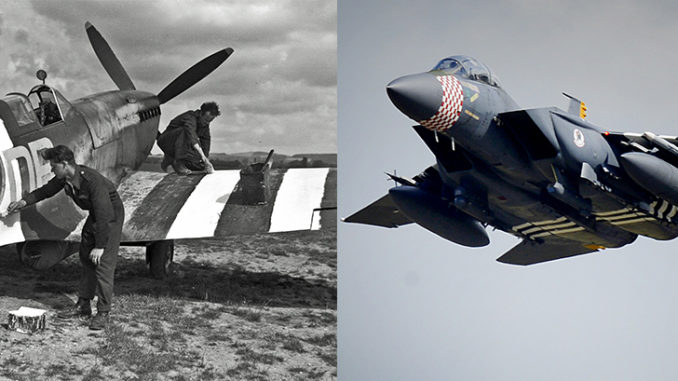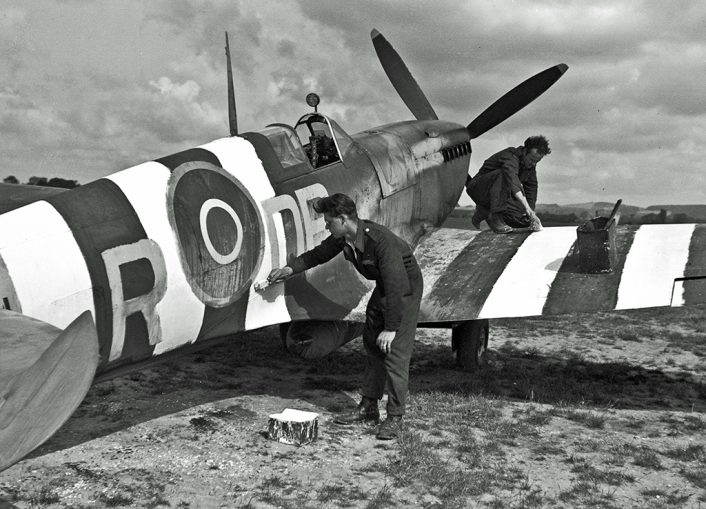

As special commemorative events in Normandy, France and around the world are held to observe the anniversary of the D-Day invasion, both modern and vintage military aircraft will take part in massive flyovers and parachute drops. One of the most unique things many of these commemorative and modern aircraft will share is bands of alternating black and white stripes around their wings and fuselage, the distinctive markings called “invasion stripes”.
Invasion stripes, the black and white bands hastily painted on aircraft in the days prior to the June 6, 1944 D-Day invasion, have become a hallmark of what was one of the greatest armed conflicts in human history, “Operation Overlord”.

The idea for invasion stripes was born out of the need to avoid “fratricide” or “friendly fire”, the accidental shooting down of allied aircraft by friendly forces during and immediately following the massive D-Day invasion. This was a threat in air-to-air combat and especially dangerous as allied aircraft overflew ships equipped with anti-aircraft guns as they transited the English Channel during and in support of the invasion forces in the day and weeks that followed.
The plan to use the alternating black and white bands was first finalized and approved on May 17, 1944. This left only 20 days for allied air forces to receive the specifications for how the markings were to be applied, and then to apply them to a boggling number of different types of aircraft. According to one historical account, a staggering 11,590 Allied aircraft flew 14,674 sorties on D-Day. Nearly all of the aircraft wore invasion stripes. Among the last aircraft to receive the special “IFF” or “Identification, Friend or Foe” markings were the massive fleet of more than 1,200 C-47 Dakota transport/paratroop delivery and glider tug aircraft.
According to most historical accounts, invasion stripes were conceived and approved by then-Air Chief Marshall Sir Trafford Leigh-Mallory. Leigh-Mallory was a sometimes-controversial commander of the Allied Expeditionary Air Forces in 1944, but his idea proved to be not only effective, but has gone on to signify the remembrance of the D-Day invasion on aircraft to this day.

This remains true even though the first invasion stripes on aircraft were actually ordered to be removed a month following the D-Day landings. The unique, one-time markings were entirely gone from allied aircraft by the end of 1944 since the bright, contrasting markings interfered with the effectiveness of camouflage schemes. But for the 75th anniversary of D-Day, invasion stripes on aircraft made a big comeback.

While invasion stripes on WWII aircraft were roughly applied by ground crews hand-painting aircraft with brush or roller, modern interpretations of invasion stripes are meticulously applied to aircraft like the three F-15s of the USAF’s 48th Fighter Wing and the C-130 Hercules tactical transports of the 123rd Airlift Wing from Kentucky Air National Guard Base in Louisville, Kentucky. Each of these aircraft will participate in special events commemorating D-Day air operations.

Eventually, and somewhat sadly, the invasion stripes will come off most of the operational USAF aircraft during regular depot maintenance when paint schemes are overhauled. The next time we see so many aircraft wearing invasion stripes will likely be a quarter century from now when we commemorate the 100th anniversary of the D-Day landings. That is a long time to wait, and makes the appearance of all these specially marked aircraft, and the preservation of the historical aircraft that wear invasion stripes, all the more special.

Tom Demerly is a feature writer, journalist, photographer and editorialist who has written articles that are published around the world on TheAviationist.com, TACAIRNET.com, Outside magazine, Business Insider, We Are The Mighty, The Dearborn Press & Guide, National Interest, Russia’s government media outlet Sputnik, and many other publications. Demerly studied journalism at Henry Ford College in Dearborn, Michigan. Tom Demerly served in an intelligence gathering unit as a member of the U.S. Army and Michigan National Guard. His military experience includes being Honor Graduate from the U.S. Army Infantry School at Ft. Benning, Georgia (Cycle C-6-1) and as a Scout Observer in a reconnaissance unit, Company “F”, 425th INF (RANGER/AIRBORNE), Long Range Surveillance Unit (LRSU). Demerly is an experienced parachutist, holds advanced SCUBA certifications, has climbed the highest mountains on three continents and visited all seven continents and has flown several types of light aircraft.